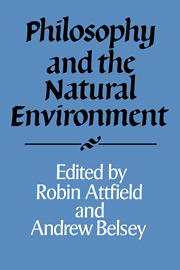Book contents
- Frontmatter
- Contents
- Preface
- Notes on Contributors
- Introduction
- Value in Nature and the Nature of Value
- Ecology and the Ethics of Environmental Restoration
- Rehabilitating Nature and Making Nature Habitable
- Personalistic Organicism: Paradox or Paradigm?
- Values, Reasons and the Environment
- Awe and Humility: Intrinsic Value in Nature. Beyond an Earthbound Environmental Ethics
- The End of Anthropocentrism?
- Global Religion
- Kant and the Moral Considerability of Non-Rational Beings
- The Idea of the Environment
- Chaos and Order, Environment and Anarchy
- Natural Capital
- Some Philosophical Assessments of Environmental Disobedience
- Global Environmental Justice
- Environmental and Medical Bioethics in Late Modernity: Anthony Giddens, Genetic Engineering and the Post-Modern State
- Highlights and Connections
- Bibliography
- Index
Chaos and Order, Environment and Anarchy
Published online by Cambridge University Press: 19 October 2009
- Frontmatter
- Contents
- Preface
- Notes on Contributors
- Introduction
- Value in Nature and the Nature of Value
- Ecology and the Ethics of Environmental Restoration
- Rehabilitating Nature and Making Nature Habitable
- Personalistic Organicism: Paradox or Paradigm?
- Values, Reasons and the Environment
- Awe and Humility: Intrinsic Value in Nature. Beyond an Earthbound Environmental Ethics
- The End of Anthropocentrism?
- Global Religion
- Kant and the Moral Considerability of Non-Rational Beings
- The Idea of the Environment
- Chaos and Order, Environment and Anarchy
- Natural Capital
- Some Philosophical Assessments of Environmental Disobedience
- Global Environmental Justice
- Environmental and Medical Bioethics in Late Modernity: Anthony Giddens, Genetic Engineering and the Post-Modern State
- Highlights and Connections
- Bibliography
- Index
Summary
Chaos and Order
The distinction between chaos and order has been central to western philosophy, both in metaphysics and politics. At the beginning, it was intrinsic to presocratic natural philosophy, and shortly after that to the cosmology and social philosophy of Plato. Even in the pre-presocratic period there were important intimations of it. Thus Hesiod tells us that ‘first of all did Chaos come into being’ (Theogony, line 116, in Kirk et al., 1983, p. 35)—although exactly what is meant by ‘chaos’ in this context is not clear. (It could be some sort of undifferentiated, primordial mass, or just the separation (the gap) between earth and sky (Kirk et al., 1983, pp. 38–41). Nor does Hesiod concern himself with what Chaos came from (Barnes, 1987, p. 57).) The myth of origin in the Theogony, though, can be seen in contrast to the underlying theme of Works and Days, namely, Zeus's eternal rule over the world in accordance with Justice or Order (Kirk et al., 1983, pp. 34, 72). This point will become centrally important in what follows.
What distinguishes the presocratics from their predecessors, according to the modern commentators, is that the ideas of the former depend on and exemplify a definite shift from a mythopoeic to a rationalistic, philosophical, proto-scientific mode of thought.
- Type
- Chapter
- Information
- Philosophy and the Natural Environment , pp. 157 - 168Publisher: Cambridge University PressPrint publication year: 1994



